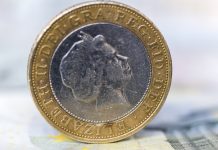The pound US dollar exchange rate dived lower before rebounding and making back a good part of the losses. The pair dropped to a low of US$1.3147 on Brexit news before moving higher following the Federal Reserve monetary policy announcement. The pair closed at US$1.3196, 0.5% down on the day.
| What do these figures mean? |
|---|
|
When measuring the value of a pair of currencies, one set equals 1 unit and the other shows the current equivalent. As the market moves, the amount will vary from minute to minute. For example, it could be written: 1 GBP = 1.28934 USD Here, £1 is equivalent to approximately $1.29. This specifically measures the pound’s worth against the dollar. If the US dollar amount increases in this pairing, it’s positive for the pound. Or, if you were looking at it the other way around: 1 USD = 0.77786 GBP In this example, $1 is equivalent to approximately £0.78. This measures the US dollar’s worth versus the British pound. If the sterling number gets larger, it’s good news for the dollar. |
The pound was under pressure in the previous session after UK Prime Minister Theresa May requested a short extension to Article 50 from Brussels. The EU have confirmed that they will not be discussing the extension when they meet for the European summit today. This means that the UK could still be unsure whether it will be granted the extension with just days to go until it is due to exit.
The EU is also sending the message that the extension will only be granted if the UK agrees to Theresa May’s deal. The chances of a no deal Brexit have increased considerably. As a result, the pound moved lower.
| Why is a “soft” Brexit better for sterling than a “hard” Brexit? |
|---|
| A soft Brexit implies anything less than UK’s complete withdrawal from the EU. For example, it could mean the UK retains some form of membership to the European Union single market in exchange for some free movement of people, i.e. immigration. This is considered more positive than a “hard” Brexit, which is a full severance from the EU. The reason “soft” is considered more pound-friendly is because the economic impact would be lower. If there is less negative impact on the economy, foreign investors will continue to invest in the UK. As investment requires local currency, this increased demand for the pound then boosts its value. |
Today attention will be on the Bank of England’s monetary policy announcement. The central bank took a more pessimistic view on the outlook of the UK economy last time it met. However, with the outcome of Brexit still unknown the BoE have their hands tied. The bank is unlikely to take any action until they have more clarity over whether the UK will leave with a deal or not.
Fed More Cautious Than Analysts Predicted
As market participants had forecast, the Fed left interest rates unchanged. However, there were plenty of other clues from the Fed that pointed towards a more dovish outlook. The US central bank lowered the outlook for economic growth in 2019 to 2.1%, down from 2.3%. The inflation forecast was also lowered to 1.8%, down from 1.9%.
US economic data has pointed to a slowing of the US economy. Meanwhile external risks such as Brexit and the US -Sino trade dispute are still present and laden with uncertainty.
With lower growth and inflation, the Fed are less willing to raise rates. Policy makers now see rates on hold until 2020. The pushing back of any rate hike pulled the dollar lower.
| Why do raised interest rates boost a currency’s value? |
|---|
| Interest rates are key to understanding exchange rate movements. Those who have large sums of money to invest want the highest return on their investments. Higher interest rate environments tend to offer higher yields. So, if the interest rate or at least the interest rate expectation of a country is relatively higher compared to another, then it attracts more foreign capital investment. Large corporations and investors need local currency to invest. More local currency used then boosts the demand of that currency, pushing the value higher. |
This publication is provided for general information purposes only and is not intended to cover every aspect of the topics with which it deals. It is not intended to amount to advice on which you should rely. You must obtain professional or specialist advice before taking, or refraining from, any action on the basis of the content in this publication. The information in this publication does not constitute legal, tax or other professional advice from TransferWise Inc., Currency Live or its affiliates. Prior results do not guarantee a similar outcome. We make no representations, warranties or guarantees, whether express or implied, that the content in the publication is accurate, complete or up to date. Consult our risk warning page for more details.
This article was initially published on TransferWise.com from the same author. The content at Currency Live is the sole opinion of the authors and in no way reflects the views of TransferWise Inc.





